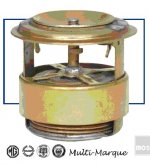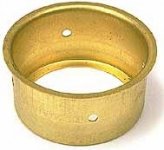Steve/All,
The doc posted on cooling the Tiger validated a number of things I have been thinking and pointed to some that are quite intriguing. As you know, the things I have added to cool my Healey are both simple and innocuous (unnoticeable). Some of the recommendations in the article do fall in that area and can be easily adopted.
To start with, I was never a proponent of pusher fans as I always thought they blocked air when driving. The article has validated that thought and the benefit of an electric fan with fewer blades. After taking the original air conditioning compressor and supporting components (including the engine-mounted thermostatic radiator fan) from my 1979 TR7, I left the 2 thermostatically-controlled air conditioning 3-blade cooling fans mounted below the radiator. Of significance, mounted low and in front of the radiator, these 2 fans provide no air block at speed and, when at idling, direct an air up to intersect the radiator's fins at an angle. Although these fans were only meant to assist in cooling when the air conditioner was active, they are now functioning as the only provider of cooling air to the radiator and are efficient enough to keep the TR7 cool enough to survive at idle for hours on a 100 degree day.
Now, when considering the potential of hot engine compartment air being re-circulated through the radiator and progressively increasing the environment’s temperature, this is definitely something I believe happens in our Healeys. Again, the TR7’s engine tub with fully enclosed radiator and bulkhead eliminates the forward passage of already-heated engine compartment air. Additionally, with louvers in the bonnet, air is vented out of the engine compartment resulting in the venting and elimination of any high pressure air block that could form.
Our Healeys are definitely plagued by porous radiator bulkheads and, at idle, build pressurized bubbles of hot air in the engine compartments and are constrained by minimal restrictive containment from the radiator bulkhead. Large openings around the steering box, beside the radiator and between the cross member allow large amounts of hot engine compartment air to pass back to the front of the radiator and pulled through again and again. As a result, when at idle, we can often see the temperature slowly increase.
At this point I feel it is not which fan to choose or even what radiator to install but how to improve the air flow within the engine compartment. Sealing the radiator bulkhead is one approach that, I feel, can never be fully achieved. However, it is possible to diminish the present free flow of air through the bulkhead and reduce the effect of hot air re-circulation. But, unless your Healey is partially disassembled, as when Steve addressed the issue, access to many of these openings for remediation would be quite difficult … if not impossible. I wonder if it would be more productive to attempt to reasonably seal the passage to the radiator by completing the closure of the deflector panels and extending this closed path to the grill. Last, I wonder if the installation of 1 or 2 thermostatically controlled Electric assist fans could be embedded within these added panels and out of the radiator’s cool air stream to provide added flow when needed.
Well, that's it for now. What are your thoughts?
Regards,
Ray (64BJ8P1)

 Hey there Guest!
Hey there Guest!
 smilie in place of the real @
smilie in place of the real @
 Pretty Please - add it to our Events forum(s) and add to the calendar! >>
Pretty Please - add it to our Events forum(s) and add to the calendar! >> 






 A friendly reminder - be careful what links you click on here. If a link is posted by someone you don't know, or the URL looks fishy, DON'T CLICK. Spammers sometimes post links that lead to sites that can infect your computer, so be mindful what you click.
A friendly reminder - be careful what links you click on here. If a link is posted by someone you don't know, or the URL looks fishy, DON'T CLICK. Spammers sometimes post links that lead to sites that can infect your computer, so be mindful what you click.